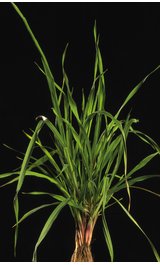Hakari Alaska brome (Bromus sitchensis) is a unique grass. Hakari is an impressive, late-maturing bromegrass that produces extremely high yields of quality forage. It is adapted to the severe winter climates. Hakari is a tall, broad-leaved, sparsely tillering bromegrass with an erect rather than creeping growth pattern. Hakari has good spring re-growth and also produces leafy summer growth. Hakari exhibits drought tolerance and is resistant to rust.
Uses
Hakari is ideal for hay production because it dries rapidly. It performs well as a monoculture, as a component of a grass mixture, or as a component in a mixed seeding with legumes. As a companion with a legume, Hakari increases the energy value of the forage. Hakari performs well with a premium red clover such as Freedom! or a high quality alfalfa adapted to your region. Optimal harvest intervals are similar for Hakari and alfalfa with 3-5 dormancy ratings. Hakari is an ideal grass for interplanting into an existing alfalfa stand to extend stand life – improving yield and quality. It is also suited to grazing and haylage/baleage production. It maintains palatability at seedhead stage of growth. Hakari is suitable for stockpiling
Establishment
Hakari is recognized for its rapid establishment. It can be planted in spring or early fall. Hakari performs best if planted on well-drained soils. To ensure good establishment, Hakari seed is de-awned. Hakari may be planted into a cultivated seedbed or via no-till drill method. Independent of the method, planting depth is critical: seed should be planted no deeper than ¼ inch. For no-till plantings, suppression of existing forage promotes establishment.
Management
In a pure stand, Hakari requires adequate rest periods to promote stand life. Rotational grazing systems should be implemented with a 3-4 week rest period. Cut to a 4 to 5 inch height. Excessive growth prior to winter can increase winter damage, graze or harvest prior to the onset of winter. Hakari is recognized for rapid re-growth. Given ideal conditions, Hakari provides impressive yields of high quality forage for 3 - 4 seasons. It responds well to nitrogen fertilization.



